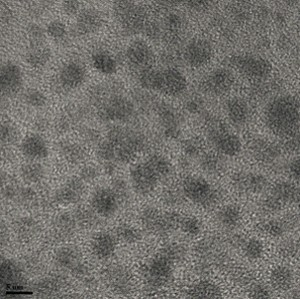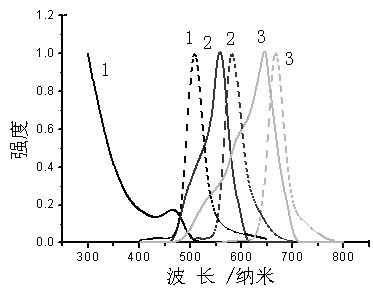Method for simultaneously detecting mercury ion and/or silver ion in water solution based on fluorescence resonance energy transfer
A fluorescence resonance energy and aqueous solution technology, which is applied in the fields of fluorescence/phosphorescence, material excitation analysis, etc., can solve the problems of heavy workload, high cost, and complicated process, and achieve the effect of low cost, small workload, and uncomplicated process
- Summary
- Abstract
- Description
- Claims
- Application Information
AI Technical Summary
Problems solved by technology
Method used
Image
Examples
Embodiment 1
[0034] (1) Preparation of CdTe quantum dots coated with mercaptopropionic acid MPA
[0035] 0.189 g (5 mmol) of sodium borohydride NaBH 4 Dissolve in a glass vial containing 2.0mL ultrapure water, add 0.1528g (1.175mmol) tellurium Te powder, leave a small hole in the cap, and then place the reaction vessel in an ice-water bath at 0°C for reaction. After 12 hours, the black Te powder disappeared, and a clear NaHTe solution was obtained for future use. Weigh 0.57g (2.5mmol) CdCl 2 2.5H 2 Dissolve O in 150mL water, add 500μL (5.74mmol) of MPA dropwise under vigorous stirring, adjust the pH to 11.20 with 0.1mol / L NaOH solution, pass N 2 After deoxygenation and protection for 30 min, the NaHTe solution prepared above was quickly added, and the precursor solution of CdTe quantum dots was obtained after the reaction. Take 40mL of the precursor solution and add it to a stainless steel reaction kettle lined with polytetrafluoroethylene, and react at 160°C for 20 minutes to obtain t...
Embodiment 2
[0050] (1) Preparation of CdTe quantum dots coated with mercaptopropionic acid MPA.
[0051] The method is as described in Example 1.
[0052] (2) Design and synthesis of nucleic acid probes for detection
[0053] The method is as described in Example 1.
[0054] (3) Preparation of fluorescent probes for quantum dots and nucleic acids (CdTe-DNA)
[0055] The method is as described in Example 1.
[0056] (4) Hg 2+ detection
[0057] The assay system was as described in Example 1, containing various concentrations (0 to 50 nM) of Hg 2+ The aqueous solution of ions was added to the above detection system, and maintained at 25°C for 0.5h, so that the Hg 2+ The induced hybridization reaction between TAMRA-DNA and DNA2 proceeded completely. The fluorescence emission spectrum of the whole system is then measured.
Embodiment 3
[0059] (1) Preparation of CdTe quantum dots coated with mercaptopropionic acid MPA.
[0060] The method is as described in Example 1.
[0061] (2) Design and synthesis of nucleic acid probes for detection
[0062] The method is as described in Example 1.
[0063] (3) Preparation of fluorescent probes for quantum dots and nucleic acids (CdTe-DNA)
[0064] The method is as described in Example 1.
[0065] (4) Ag at the same time + and Hg 2+ detection
[0066] The detection system was as described in Example 1, containing different concentrations (0 to 50 nM) of Ag + and Hg 2+ The aqueous solution was added to the above detection system, and maintained at 25°C for 0.5h, so that the Hg 2+ Induced TAMRA-DNA hybridization reaction with DNA2 and Ag + The induced hybridization reaction between Cy5-DNA and DNA2 proceeded completely. The fluorescence emission spectrum of the whole system is then measured.
PUM
 Login to View More
Login to View More Abstract
Description
Claims
Application Information
 Login to View More
Login to View More - R&D
- Intellectual Property
- Life Sciences
- Materials
- Tech Scout
- Unparalleled Data Quality
- Higher Quality Content
- 60% Fewer Hallucinations
Browse by: Latest US Patents, China's latest patents, Technical Efficacy Thesaurus, Application Domain, Technology Topic, Popular Technical Reports.
© 2025 PatSnap. All rights reserved.Legal|Privacy policy|Modern Slavery Act Transparency Statement|Sitemap|About US| Contact US: help@patsnap.com



